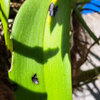When do you switch High-N, High-P Fert?
claritamaria
16 years ago
Related Stories

HOUZZ TOURSMy Houzz: High End Meets Budget Friendly in Toronto
Splurging selectively and saving elsewhere, a Canadian family gets a posh-looking home that matches their vision
Full Story
KITCHEN DESIGNThe Return of the High-Back Farmhouse Sink
See why this charming and practical sink style is at home in the kitchen and beyond
Full Story
GREAT HOME PROJECTSHow to Switch to a Tankless Water Heater
New project for a new year: Swap your conventional heater for an energy-saving model — and don’t be fooled by misinformation
Full Story
GARDENING GUIDESHow to Switch to an Organic Landscape Plan
Ditch the chemicals for a naturally beautiful lawn and garden, using living fertilizers and other nontoxic treatments
Full Story
LIFEWhen a Household Divides — How to Reinvent Your Home Style
Consider starting over an opportunity to discover yourself anew. Here, some insight to help you create a freshly inspiring home
Full Story
KITCHEN APPLIANCESWhat to Consider When Adding a Range Hood
Get to know the types, styles and why you may want to skip a hood altogether
Full Story
BLACKCooking With Color: When to Use Black in the Kitchen
Consider sampling Caviar or Cracked Pepper on your kitchen walls or cabinets for richness and impact
Full Story
KITCHEN DESIGNCooking With Color: When to Use White in the Kitchen
Make sure your snowy walls, cabinets and counters don't feel cold while you're riding white's popularity peak
Full Story
KITCHEN DESIGNDiscover the Pull of Microwave Drawers
More accessible, less noticeable and highly space efficient, microwave drawers are a welcome newcomer in kitchen appliances
Full Story
GREEN BUILDINGEcofriendly Cool: Insulate With Wool, Cork, Old Denim and More
Learn about the pros and cons of healthier alternatives to fiberglass and foam, and when to consider an insulation switch
Full StoryMore Discussions









mehitabel
highjack
Related Professionals
Ballenger Creek Landscape Architects & Landscape Designers · Brentwood Landscape Architects & Landscape Designers · Glassmanor Landscape Architects & Landscape Designers · Matthews Landscape Contractors · Bound Brook Landscape Contractors · Cornelius Landscape Contractors · Crystal Landscape Contractors · Parkland Landscape Contractors · Pine Hills Landscape Contractors · Rancho Santa Margarita Landscape Contractors · Shoreview Landscape Contractors · Sugar Hill Landscape Contractors · Florida City General Contractors · Parsons General Contractors · Wallington General Contractorsrichardol
aachenelf z5 Mpls
mrbreeze
jane__ny
toyo2960
aachenelf z5 Mpls
claritamariaOriginal Author
aachenelf z5 Mpls
mehitabel
claritamariaOriginal Author
aachenelf z5 Mpls
arthurm
jane__ny
cjwatson